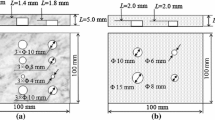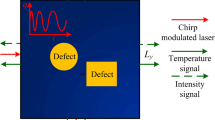Abstract
The photothermal imaging technique is a nondestructive inspection technique that visualizes the inside of a metal by utilizing the photothermal effect. Although the concept of photothermal imaging techniques has been proposed, systematic research on the characteristics thereof has not been conducted. This study attempts to enhance the measurement and reconstruction process for a photothermal imaging method. To detect the edge of a subsurface pattern more accurate, low-pass FFT (fast Fourier transform) filter for noise reduction of measured data, and derivative detectors are adopted for the reconstruction of photothermal imaging. The adopted methods are applied to and visualize 20 mm × 25 mm × 1.5 mm copper block including radius 5 mm, height 1 mm cylindrical resin as a subsurface pattern. The results show that the developed method can detect the edge of the resin subsurface 50% more accurately than the previous reconstruction method for photothermal imaging.
Graphical abstract








Similar content being viewed by others
References
Ahmad MB, Choi T-S (1999) Local threshold and boolean function based edge detection. IEEE Trans Consum Electron 45:674–679
Antoniou A (2016) Digital signal processing. McGraw-Hill, New York
Bagavathiappan S, Lahiri B, Saravanan T, Philip J, Jayakumar T (2013) Infrared thermography for condition monitoring–A review. Infrared Phys Technol 60:35–55
Berciaud S, Cognet L, Blab GA, Lounis B (2004) Photothermal heterodyne imaging of individual nonfluorescent nanoclusters and nanocrystals. Phys Rev Lett 93:257402. https://doi.org/10.1103/PhysRevLett.93.257402
Ciampa F, Mahmoodi P, Pinto F, Meo M (2018) Recent advances in active infrared thermography for non-destructive testing of aerospace components. Sensors (Basel) 18:609. https://doi.org/10.3390/s18020609
Cooley J, Lewis P, Welch P (1967) Historical notes on the fast fourier transform. IEEE Trans Audio Electroacoust 15:76–79
Friedrich K, Haupt K, Seidel U, Walther HG (1992) Definition, resolution, and contrast in photothermal imaging. J Appl Phys 72:3759–3764
Gao B, He Y, Woo WL, Tian GY, Liu J, Hu Y (2016) Multidimensional tensor-based inductive thermography with multiple physical fields for offshore wind turbine gear inspection. IEEE Trans Industr Electron 63:6305–6315
Haynes WM (2014) CRC handbook of chemistry and physics. CRC Press, Boca Raton
Heideman M, Johnson D, Burrus C (1984) Gauss and the history of the fast fourier transform. IEEE ASSP Magazine 1:14–21
Jafarzadeh H, Udoye CI, Kinoshita J-I (2008) The application of tooth temperature measurement in endodontic diagnosis: a review. J Endod 34:1435–1440
Jeon P, Lee E, Lee K, Yoo J (2001) A theoretical study for the thermal diffusivity measurement using photothermal deflection scheme. Energy Eng J 10:63–70
Kim M, Yoo J, Kim D-K, Kim H (2015) Numerical study on visualization method for material distribution using photothermal effect. J Mech Sci Technol 29:4499–4507
Kim M, Kim G, Yoo J, Kim D-K, Kim H (2018) Experimental study on the influence of surface roughness for photothermal imaging with various measurement conditions. Thermochim Acta 661:7–17
Körner TW (1989) Fourier analysis. Cambridge University Press, Cambridge
Maini R, Aggarwal H (2009) Study and comparison of various image edge detection techniques. Int J Image Process (IJIP) 3:1–11
Marr D, Hildreth E (1980) Theory of edge detection. Proc R Soc Lond B 207:187–217
McDonald FA, Wetsel Jr GC, Stotts SA (1982) Scanned photothermal imaging of subsurface structure. In: Acoustical imaging, pp 147–155
McDonald FA, Wetsel Jr GC, Jamieson GE (1985) Spatial resolution of subsurface structure in photothermal imaging. In: Acoustical imaging, pp 377–385
Murphy JC, Aamodt LC (1981) Optically detected photothermal imaging. Appl Phys Lett 38:196–198
Murphy JC, Spicer JWM, Aamodt LC, Royce BSH (1990) Photoacoustic and photothermal phenomena II. Springer Series in Optical Sciences, 62
Nadernejad E, Sharifzadeh S, Hassanpour H (2008) Edge detection techniques: evaluations and comparisons. Appl Math Sci 2:1507–1520
Natterer F, Wübbeling F (2001) Mathematical methods in image reconstruction, vol 5. SIAM, Philadelphia
Owens R (1997) Lecture 6 computer vision IT412 10:29
Price S (1996) Edges: the canny edge detector. July
Prince JL, Links JM (2006) Medical imaging signals and systems. Pearson Prentice Hall, Upper Saddle River
Salazar A, Sánchez-Lavega A, Fernandez J (1991) Thermal diffusivity measurements in solids by the ‘‘mirage’’ technique: experimental results. J Appl Phys 69:1216–1223
Salazar A, Sánchez-Lavega A, Fernández J (1993) Thermal diffusivity measurements on solids using collinear mirage detection. J Appl Phys 74:1539–1547
Sell J (2012) Photothermal investigations of solids and fluids. Elsevier, New York
Wang Y et al (2018) Thermal pattern contrast diagnostic of micro cracks with induction thermography for aircraft braking components. IEEE Trans Industr Inform. https://doi.org/10.1109/TII.2018.2802046
Wetsel GC Jr, McDonald FA (1984) Resolution and definition in photothermal imaging. J Appl Phys 56:3081–3085
Acknowledgments
This research was supported partly by the Basic Science Research Program through the National Research Foundation of Korea (NRF) funded by the Ministry of Education (NRF-2015R1D1A1A01060704 and NRF-2017R1D1A1B03035832).
Author information
Authors and Affiliations
Corresponding author
Appendix
Appendix
In this appendix, we describe in detail the process of obtaining the smoothed result using the low-pass FFT filter from the experimental data in Fig. 4.
To explain the smoothing process, it is necessary to clarify the Fourier transform. Equations (1, 2) are a general expression for Fourier transform. As is already well known, the function of the spatial domain \(f(x)\) can be represented by the integration of sinusoidal functions (\(e^{{i\omega_{s} x}}\), Euler’s formula) such as sine/cosine, and the amplitude and phase information of the sinusoidal function is included in \(F(\omega_{s} )\). Therefore, complex numbers (sinusoidal function), amplitude and phase can be obtained by performing FFT. Figure 8 shows the graphs for the real part of the complex numbers (sinusoidal functions) and amplitude of the FFT result on the experimental data.
In this study, a low-pass FFT filter is designed based on amplitude to remove noise for small amplitude. To remove the noise, the following transformation process was performed. First, as shown in Fig. 9a, the cutoff spatial frequency is determined as the bottom 5% of amplitude for the maximum one the FFT result. According to the cutoff spatial frequency, only the lower spatial frequency signals than the 5% cutoff one are left from the experimental result, as shown in Fig. 9a. Then, the filtered FFT result using the low-pass filter (which depends on the filter criteria) is restored to a smoothed signal through the IFFT. The same transformation process applies to all other filter criteria (1%, 0.5%, 0.05%).
Rights and permissions
About this article
Cite this article
Kim, M., Yoo, J., Kim, DK. et al. Development on the reconstruction of photothermal imaging method for subsurface structure. J Vis 22, 329–339 (2019). https://doi.org/10.1007/s12650-018-0533-z
Received:
Revised:
Accepted:
Published:
Issue Date:
DOI: https://doi.org/10.1007/s12650-018-0533-z






